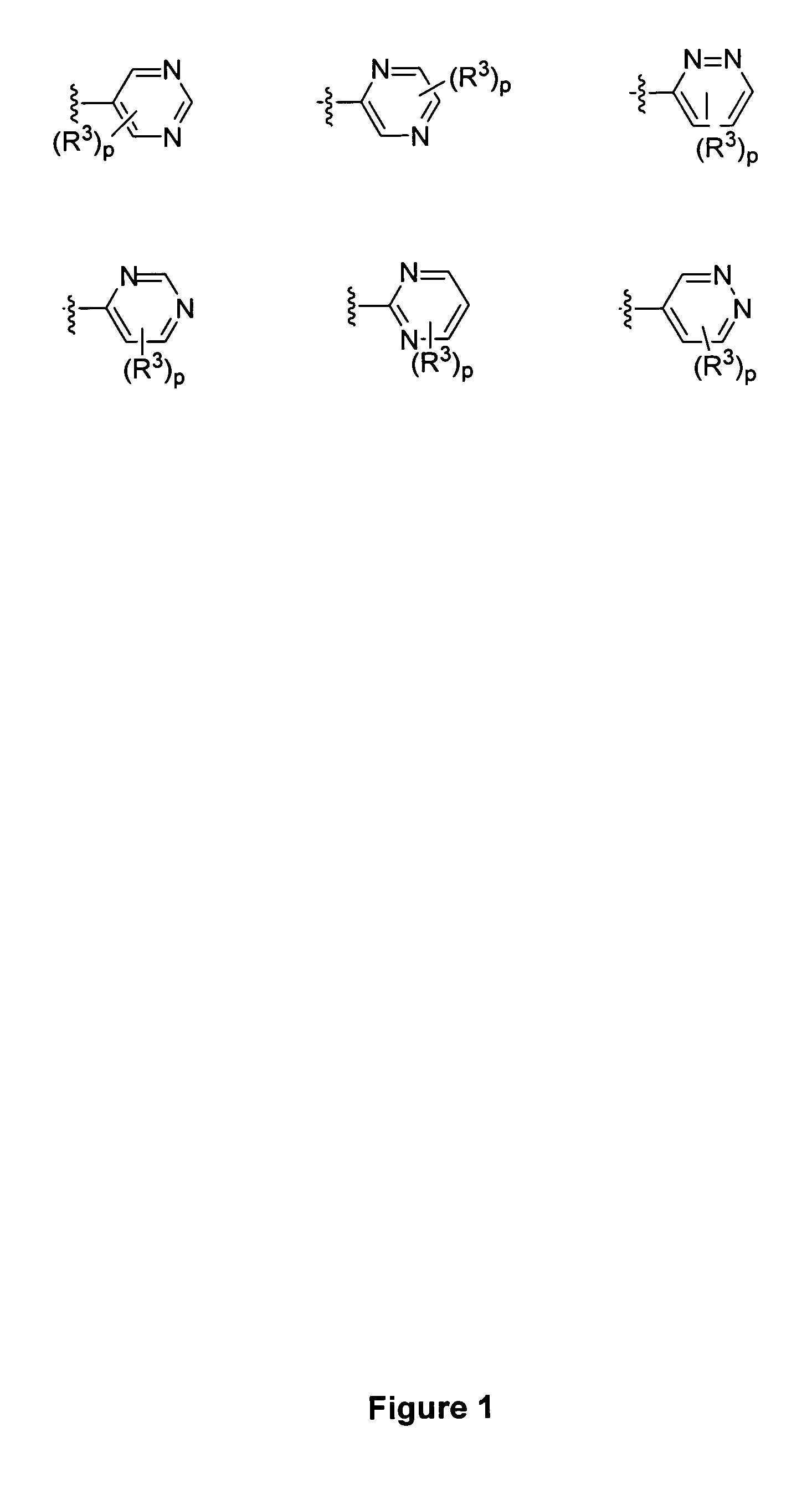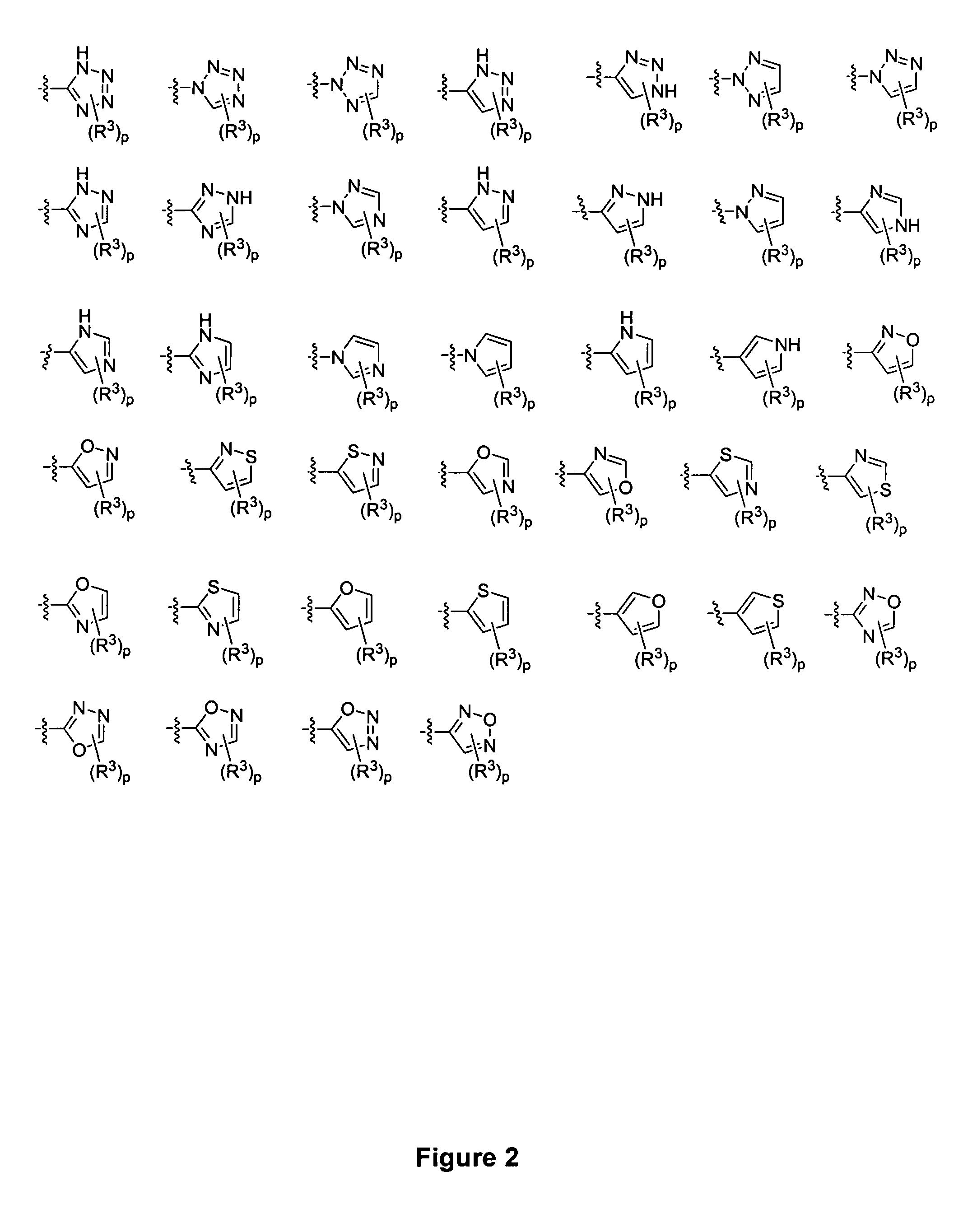Piperidine derivatives and methods of use
a technology of piperidine and derivatives, applied in the field of piperidine derivatives and methods of use, can solve the problems of inability to meet the needs of use, short half-live of piperidine once administered, and inability to meet the requirements of use,
- Summary
- Abstract
- Description
- Claims
- Application Information
AI Technical Summary
Benefits of technology
Problems solved by technology
Method used
Image
Examples
example 1
2-(4-Chloro-5-methyl-3-(2-oxazolyl)-pyrazol-1-yl)-1-[4-(4-fluoro-benzyl)-4-hydroxy-piperidin-1-yl]-ethanone
[0138]
[0139]To a 20 mL vial equipped with a magnetic stirring bar was added 63 mg of 4-(4-Fluoro-benzyl)-piperidin-4-ol (0.3 mmol, 1.2 equiv.), 62 mg of (4-Chloro-5-methyl-3-oxazol-2-yl-pyrazol-1-yl)-acetic acid (0.26 mmol, 1.0 equiv), and 138 mg of benzotriazol-1-yloxy)tripyrrolidinophosphonium hexafluorophosphate (0.27 mmol, 1.0 equiv). The reagents were dissolved in 0.6 mL of DMA and to the resultant solution was added 0.18 mL of DIPEA (1.0 mmol, 3.8 equiv.). The reaction solution was stirred for 14 h and then poured into 50 mL of EtOAc. The organic extracts were washed with saturated aq. NaCl (5×10 mL), 1% aq NaOH (1×10 mL), and 0.1 N HCl (1×10 mL). The organic extracts were dried over MgSO4 and concentrated in vacuo to afford a yellow oil, which was purified by preparative HPLC to afford 34 mg of 2-(4-Chloro-5-methyl-3-oxazol-2-yl-pyrazol-1-yl)-1-[4-(4-fluoro-benzyl)-4-hyd...
example 2
Synthesis of 3-(4-Chloro-5-methyl-3-trifluoromethyl-pyrazol-1-yl)-1-[4-(4-fluoro-benzyl)-4-hydroxy-piperidin-1-yl]-propan-1-one
[0140]
[0141]The title compound was prepared according to the procedure described in scheme above. LCMS observed for (M+H)+: 448.2
example 3
(E) and (Z) 3-(4-Chloro-5-methyl-3-trifluoromethylpyrazol-1-yl)-acrylic acid
[0142]
[0143]To a vial containing 4-Chloro-5-methyl-3-trifluoromethyl-1H-pyrazole (2.83 g, 15.3 mmol) was added MeOH (5 mL) and ethyl propiolate (1.94 g, 19.7 mmol) and acetic acid (100 μL). The vial was capped and the reaction mixture was heated to 80° C. for 20 h. After cooling to room temperature, the volatiles were removed in vacuo to afford the crude products, which were purified by flash chromatography on silica gel (120 g) using gradient elution (0%-75% EtOAc in hexanes over 15 column volumes). The fractions containing the E and Z esters were collected separately and concentrated in vacuo. Each product was then transferred to a separate vial using THF (10 mL). Both vials were treated with a 1.0 N solution of LiOH (10 mL). The vials were heated to 40° C. After 2 h, the solutions were cooled, and each was diluted with water (50 mL). The pH was adjusted to 1 with 4 N HCl. Each aqueous phase was extracted ...
PUM
 Login to View More
Login to View More Abstract
Description
Claims
Application Information
 Login to View More
Login to View More - R&D
- Intellectual Property
- Life Sciences
- Materials
- Tech Scout
- Unparalleled Data Quality
- Higher Quality Content
- 60% Fewer Hallucinations
Browse by: Latest US Patents, China's latest patents, Technical Efficacy Thesaurus, Application Domain, Technology Topic, Popular Technical Reports.
© 2025 PatSnap. All rights reserved.Legal|Privacy policy|Modern Slavery Act Transparency Statement|Sitemap|About US| Contact US: help@patsnap.com



